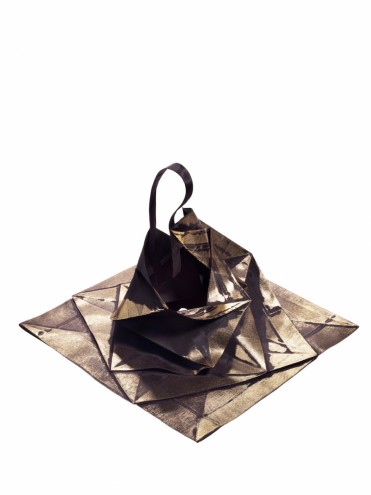Traditional crafts such as pleating, quilting and embroidery have permeated contemporary product design so deeply that is difficult to draw distinctions today between "craft" and "design". The number of furniture, product and textile designers included in Lidewij Edelkoort's new exhibition at the Design Museum Holon attests to this. GATHERING: From Domestic Craft to Contemporary Process showcases works by more than 70 contemporary designers from around the world: big names such as Dror Benshetrit, Toord Boontje, Erwan & Ronan Bouroullec, Arik Levy, Patricia Urquiola, Marcel Wanders, Inga Sempé, Tokujin Yoshioka and Nendo are there; while lesser-known designers – mostly from Europe and Israel – include Ditte Hammerstrom, Jorrit Taekema and Ayala Serfaty.
The exhibition, co-curated with Philip Fimmano, traces the threads of this preoccupation with craft to a current thirst for antidotes to our homogenised, global world and its digital hyper-realities. The craft techniques highlighted in the exhibition are defined "as the repetition of skills that belong to our common past, exuding a sense of belonging and continuity."
The techniques, which form categories of products on display, include pleating, draping, layering, ribboning, smocking, wrapping, folding, needlework, felting, quilting and even baking.
These historical and traditional handmade skills are being given new life through new technologies and techniques, ultimately transforming their handmade actions. These new interventions celebrate the possibilities in creativity and the future of design, Edelkoort says.
Edelkoort explains the exhibition’s context: "We are an unstitched society suffering from a lasting socio-economic crisis that has made us ferociously protective and egocentric. It is time for mending and gathering, thus restoring the fabric of society: picking up the pieces and bringing them back together in a patchwork of possibilities; a quilt of substance, able to absorb shock and fear."
In today's context, Edelkoort says, traditional crafts are mirrored by the layering and weaving of different entities and characters into a single product. She reads this mixed materiality as having the social significance: "Flexible three-dimensional patterns develop enlightenment, adding dimension to the future. The pleating and folding of matter into sharper form brings innovative architecture to life and helps design plans for society."
Referring to the exhibition's title, she says: "Whether it refers to gathering friends or gathering a garment, the correlation between material transformation and social congregation is fascinating."
Indeed, it may well be that gathering will shape our culture for decades to come – creating flexible forms through restraining process, Edelkoort adds.
The focal point of the exhibition is a world-first survey of the groundbreaking 132 5. ISSEY MIYAKE collection by the legendary Japanese fashion designer.
Known for his technology-driven clothing designs, Miyake has once again pushed the boundaries of fashion design. The collection, inspired by the idea of regeneration and re-creation, is made using recycled PET products in combination with a variety of recycled fibres. The garments were made using a groundbreaking process that utilises a mathematical algorithm. First, computer scientist Jun Mitani helped select various three-dimensional shapes, which were then folded into two-dimensional forms with pre-set cutting lines that determined their final shape. Finally, they were heat-pressed to yield folded shirts, skirts and dresses.
"I’ve been thinking about the challenges we’ll have to deal with in the 21st century. Most of us feel some kind of uncertainty, with the population increasing and resources decreasing," says Miyake. "It’s important to make clothes for long-term use now, not just one season. We can’t keep throwing things away… We have to face these issues. Many people repeat the past. I’m not interested. I prefer evolution."
The exhibition is on display at the Design Museum Holon until 25 October 2014.



























